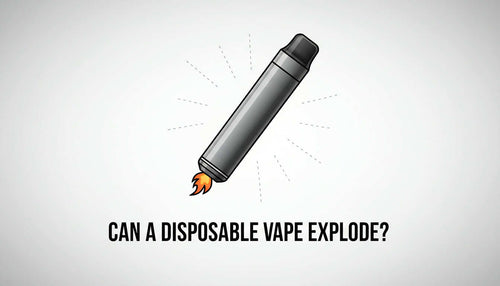Currently, single-use vapes include safety features that support the prevention of mishaps. However, it is the responsibility of users to remain vigilant and be aware of the risks.

This manual will go over the essentials regarding the safe use of disposables vapes. We will examine the dangers, factors that can lead to device failure, and ways to steer clear of such problems.
What are Disposable Vape Device Safety
Disposable vapes are becoming more popular. They provide a handy and small method of nicotine intake. These gadgets unite sophisticated technology with intelligent design.

Disposable e-cigarettes are powered by the most straightforward components. These components are necessary for the production of vapor:
- Power source for the battery
- Heat element
- Liquid reservoir
- Microprocessor board
The Main Parts of a Disposable Vape
Despite their small size, disposable vapes contain key components designed for simplicity and performance
- Battery: A small, single-use, lithium-ion battery that is already charged is what makes the device work.
- E-Liquid Tank: A unit that is closed tightly and is filled with e-liquid beforehand.
- Heating Coil: A ceramic wire is the most likely source that is used to heat the vapor you need.
How It Functions
The operation is done automatically and is triggered by breath:
- Activation: In the moment of your inhalation, the battery is turned on.
- Heating: The battery sends the required voltage to the heating coil, and thus it gets heated very fast.
- Vaporization: The coil that is still holding the e-liquid from the tank heats it and therefore the e-liquid is converted to a vapor that can be inhaled.
Safety Features in Modern Devices
Disposable vapes have gotten safer over time. They now have features like:
- Automatic shut-off mechanisms
- Short-circuit protection
- Overcharge prevention
- Temperature regulation systems
These safety features help reduce risks.
Can a Disposable Vape Explode?
Vape explosion risks are what should worry most the users of e-cigarettes. Though infrequently, the failure of a disposable vape may result in a sudden discharge of energy under some kind of situation.

The main causes of hazards are in most cases the batteries. In a situation where a lithium-ion battery in a disposable vape is exposed to some extreme conditions or there is a defect in the product, it may lead to a hazardous failure.
- Physical damage to the device
- Extreme temperature exposure
- Manufacturing quality problems
- Improper storage conditions
The United States Consumer Product Safety Commission has documented several incidents related to vaping device explosions.
| Incident Type | Frequency | Potential Damage |
|---|---|---|
| Battery Venting | More Common | Minor Burns/Device Failure |
| Actual Explosion | Rare | Severe Injury Possible |
Common Causes of Vaping Device Failures
Disposable vapes can face many technical issues. These problems can affect their safety and how well they work.

Battery Malfunction Risks
Most issues with disposable vapes come from battery problems. Lithium-ion batteries in these vapes can have serious issues like:
- Short circuit vulnerabilities
- Unexpected voltage fluctuations
- Physical damage to battery components
- Internal electrical system breakdowns
Temperature Control Issues
E-cigarette overheating is a big safety worry for vapers. If temperature control isn't right, it can cause many problems:
| Temperature Problem | Potential Consequences |
|---|---|
| Excessive Heat Buildup | Device Performance Degradation |
| Thermal Stress | Battery Expansion and Possible Failure |
| Inconsistent Heating Elements | Uneven Vapor Production |
Manufacturing Defects
Quality problems in the production of disposable vapes can raise the risk to a high level. If the manufacture is done below standard, it can cause the device to function improperly.
- Inadequate component testing
- Impure soldering methods
- Inferior material usage
- Non-uniform quality assurance procedures
Prevention and Safety Measures for Disposable Vape Users
Safe vaping is key to protecting yourself and making your e-cigarette last longer.

Following e-cigarette best practices is important. It includes how you handle and store your device. These steps are part of safe vaping guidelines.
- Purchase disposable vapes only from reputable manufacturers
- Avoid exposing devices to extreme temperatures
- Inspect your device regularly for signs of damage
- Keep vapes away from direct sunlight and moisture
In vape device management, battery safety is an essential aspect that cannot be ignored. Keep an eye for indications such as overheating, odd smells, or battery impairments.
Following are some great ideas to keep your vape safe:
- First of all, you should store your devices at normal room temperature.
- Do not let your batteries come in contact with metallic objects.
- If you can, always use the manufacturer's packaging.
- Make sure that your batteries are not subjected to any kind of impact or pressure that can cause damage.
Signs of Dangerous Disposable Vape Malfunction
Early symptoms of a malfunctioning vape should be less dangerous if you fastenedly fix them. It is essential to look for features of your electronic cigarette that indicate impending breakdown.

Physical Warning Indicators
There are visual signs that your e-cigarette might be in trouble. Look out for:
- Visible battery swelling or deformation
- Cracks in the device casing
- Discoloration around the battery or connection points
- Leaking e-liquid from unexpected areas
- Unusual odors emanating from the device
Performance Red Flags
Performance issues can also hint at problems with your vape:
- Excessive heat during normal use
- Inconsistent vapor production
- Sudden battery drainage
- Strange popping or crackling sounds
- Difficulty activating the device
When to Dispose of Your Device
If you know the time when a vape should be discarded, then it is good. The removal of defective vapes is necessary when the following is observed:
- Any signs of significant physical damage
- Persistent performance irregularities
- Unexpected changes in taste or vapor quality
- Potential battery compromise

